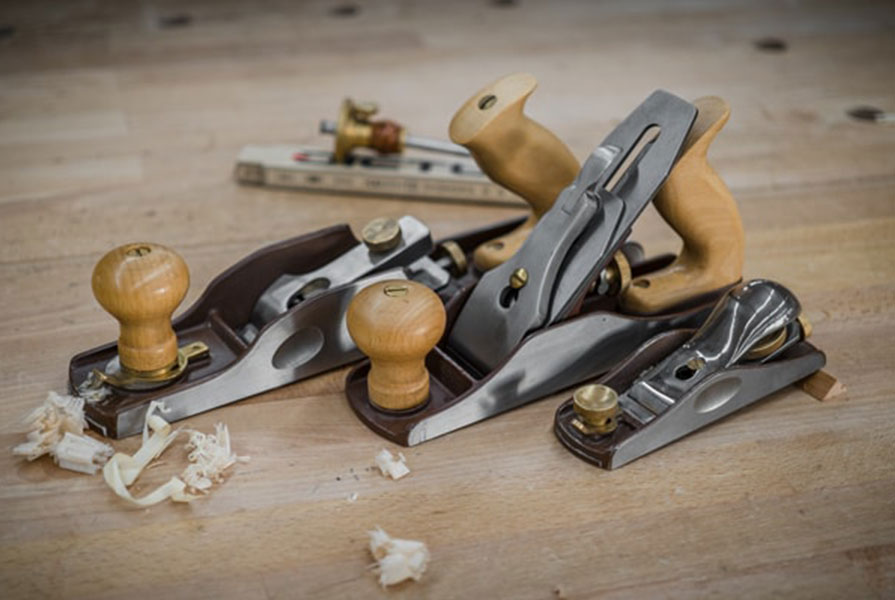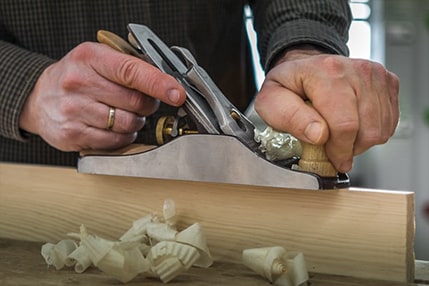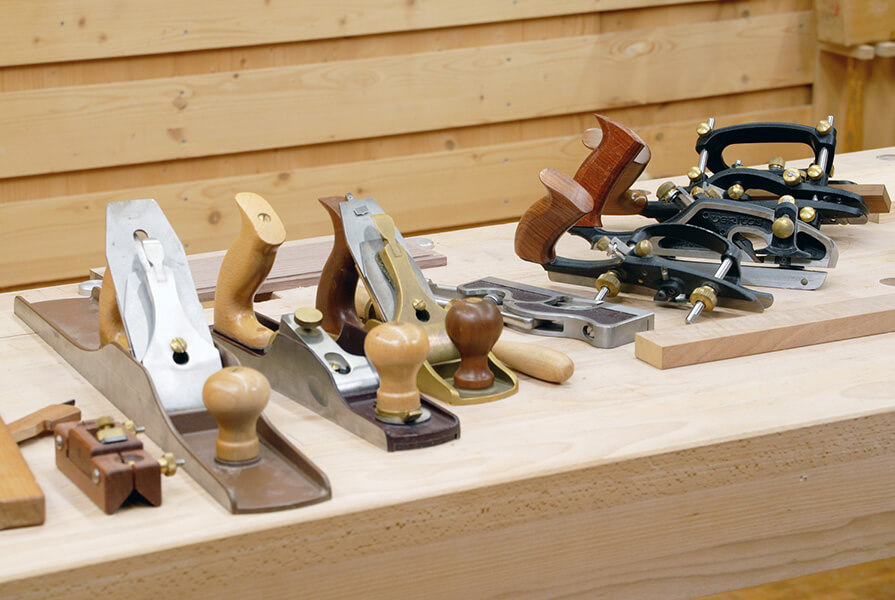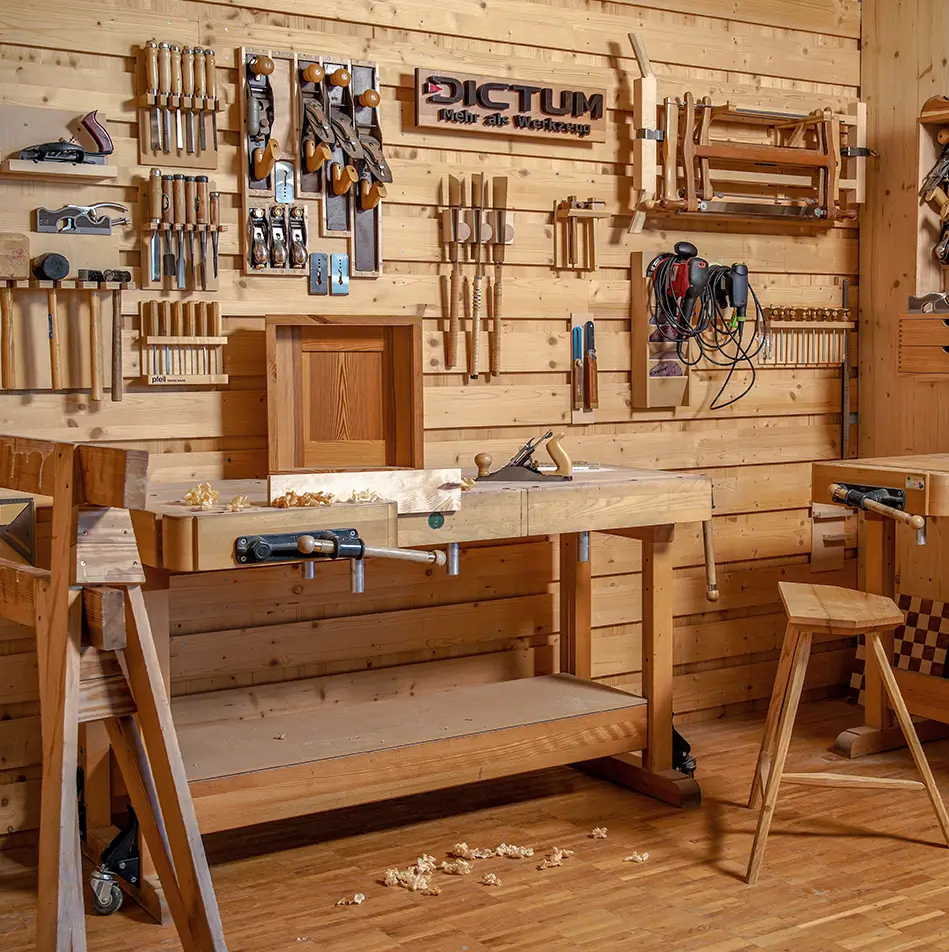
Is there a planer that I can do everything with?
Yes, there is. Theadvisors in our DICTUM shops are often asked, especially by newcomers to woodworking, whether there is a universal planer with which they can do everything. First of all: if there was a universal planer, all the different types of planes would be superfluous. However, there are planer types that are more versatile than others. We will introduce you to three standard planers, each of which can take on a wide range of different tasks in their field.
- What features are important for a hand plane?
- Is there a standard planer that every carpenter/joiner uses?
- What characterises planer no. 4?
- Is there a small universal planer for beginners?
- What can I use a single-handed plane for?
- Which planer is versatile for solid wood?
- What is a long flat-angle planer no. 62 used for?
- FAQs - Questions about hand planes
What features are important for a hand plane?
The following features are particularly important for the functionality of a planer:
- Cutting angle
- Length of the soleplate
- Width of the plane blade
- Design
The cutting angle determines how the planing knife or blade cuts into the wood fibres. For general tasks, 45° is common. For more demanding tasks, such as planing workpieces with varying grain, the angle is steeper (e.g. plaster planes with 50° to 60°). A flatter angle of approx. 35° is more suitable for processing short fibres, e.g. when planing end grain.
The length of the sole of the plane determines the surface on which the plane lies flat. Long planes, such as a so-called roughing bench, are used to plane a larger workpiece. Shorter hand planes are better able to follow slight unevenness and are used to remove or clean small chippings in the surface (e.g. finishing or plastering planes with an overall length of 250 mm). The length of the soleplate also indirectly determines the weight of the planer, as the planer box has a corresponding overall size.
The width of the plane blade is decisive for the quantity and efficiency of planes. With a wider plane, you can remove more material in one stroke than with a narrower one. However, the resistance and therefore the effort required is also greater.
There are generally two different types of hand planes: The "bevelled bottom" type is common with traditional wood planes. The iron lies in the planer box or on the iron support with the bevel facing downwards. The cutting angle is only determined by the angle of the iron carrier. On planes with the "top bevel" design, the plane iron lies on the iron carrier with the cutting bevel facing upwards. Their cutting angle is made up of the bevel angle and the angle of the iron support. This design is common for metal planes, especially so-called flat-angle planes, and offers more flexibility, as the cutting angle can be quickly adjusted by using several plane irons with different bevel angles. Find out more about cutting and bevelling angles for the different planer types in our video (external link).
Is there a standard planer that every carpenter/joiner uses?
If there is one plane that no workshop should be without, then it is a No. 4 planer, which most joiners and carpenters have on their workbench or in their toolbox.
Fig.: Finishing plane no. 4 - a must in the workshop

What characterises planer no. 4?
With an overall length of around 25 cm, this planer is long enough to smooth surfaces and also plane longer edges precisely. At the same time, a planer no. 4 is still handy enough, for example, to clean joints after gluing and to evenly chamfer a furniture edge. With a cutting or bedding angle of 45°, a No. 4 delivers clean planing results even when the grain is difficult, and is equipped with a so-called flap or chip breaker for this purpose.
Is there a small universal planer for beginners?
A so-called block plane such as the DICTUM one-hand plane, flat angle 12° is ideal for precise work, small adjustments during assembly and for cleaning wood joints. It is compact and can also be used safely by DIY enthusiasts and beginners who have little experience in handling hand planes.
Fig.: Flat-angle planer for fine planing tasks
What can I use a single-handed planer for?
This compact type of planer is ideal for fine woodworking. Thanks to its small size, it can be easily guided with just one hand. With this flat-angle planer, the plane iron lies flat in the planer box at an angle of 12°. Together with the 25° bevel angle of the plane blade, this results in a cutting angle of 37°. Such a flat angle is ideal for end grain processing, for example when cleaning joints or chamfering table and chair legs. With a second plane with a bevelling angle of 30° to 35°, this one-hand plane can easily be converted to an angle of approx. 45°. Equipped in this way, it is ideal for smaller planing jobs in the direction of the grain, such as chamfering edges and cleaning small surfaces. Its planer mouth can also be precisely adjusted for thin shavings. Its blade is only 32 mm wide, so that it requires little force when processing a surface.

Which planer is versatile for solid wood?
If you work a lot with solid wood and prepare your own wood, there's no getting round a No. 62 planer. It is also a versatile flat-angle planer that can be quickly adapted to different tasks.
What is a No. 62 long flat-angle moulding plane used for?
Due to the length of its sole, its design and its accessories, the No. 62 is the most universal type of planer, which was already very popular in Stanley's day. In addition to finishing, its long design also makes it suitable for levelling a surface. Equipped with a special toothed iron, the 62 is a perfect roughing plane for dressing. Turned to the side of the planer box and fitted with a so-called "hot dog", it is an ideal moulding plane for frame corners and precise fitting. The cutting angle can also be optimised for different types of wood and grain patterns on the No. 62 flat angle planer using additional irons with different bevel angles. Its planer mouth can also be adjusted in width and adapted to the material or chip thickness. You can find out more about this "egg-laying wool-milk sow" in planer form in our video.
Fig.: Planer no. 62 - ideally suited even for difficult materials

The 3 types in direct hand planer comparison
| Finishing plane no. 4 | Flat angle 12° | Finishing plane no. 62 | |
|---|---|---|---|
| Iron width | 50 mm | 35 mm | 50 mm |
| Cutting angle | 45° | 37° (45°) | 37° (45°) |
| Total length | 250 mm | 160 mm | 355 mm |
| Weight | 2.3 kg | 0.84 kg | 2.7 kg |
Summary
Each of the three hand planes presented in the comparison, planer no. 4, one-hand flat-angle planer with 12° and planer no. 62, covers a wide range of tasks in its field. In combination, the three planer types cover almost all regular planing tasks in the workshop. Nevertheless, specialised planers also have a right to exist. The work for which they are optimised is generally completed faster, more accurately and therefore more efficiently. Special designs such as base planes, moulding planes or tail planes take on tasks that can only be performed to a limited extent or not at all with other planes.
At DICTUM you will find all types of hand planes, standard planes and specialised planes. Find out more in our online shop. You can learn how to work precisely with hand tools in our training workshop under professional guidance. You will also find suitable workshops for sharpening plane irons and chisels.
Frequently asked questions on the topic "Hand planer comparison"
Who or what was "Stanley"?
Stanley Tools was one of the first major manufacturers of metal planes and developed a system for numbering planes of different sizes, which was also adopted by other manufacturers. The smallest plane in the original Stanley system has the number 1, the largest the number 8, later followed by further numbers for intermediate sizes and designs.
Is it strenuous to work with a heavy planer?
Here too, the planer must be suited to the task. Small adjustments and fine work, such as chamfering a longitudinal edge, are easier with a small single-handed plane. A heavy hand plane, on the other hand, rests better on the workpiece due to its own weight and has enough momentum to glide over harder areas, such as knots, due to its "inertia". Many woodworkers therefore favour larger and heavier planes for efficient work, e.g. a wider 4 1/2 with 60 mm iron instead of the narrower No. 4.
Is an electric planer more versatile than a hand planer?
Quite the opposite. An electric planer is only suitable for fast and comparatively coarse material removal. It is ideal for making adjustments during assembly, but is hardly suitable for precise woodworking or finishing and cleaning surfaces.









